

By Mike Wilmington Wilmington@moviecitynews.com
Wilmington on DVD: From Tillman to Amarcord
CO-PICKS OF THE WEEK: NEW
The Tillman Story (Three Stars)
U.S.: Amir Bar-Lev, 2010 (Sony)
The Tillman Story is a terrible story, yet finally an inspiring one, told with great reportorial skill by documentary director Amir Bar-Lev.
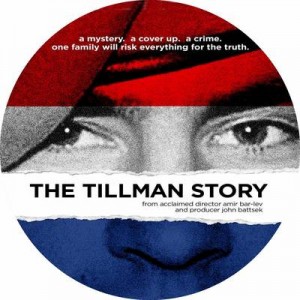 It’s the tale of an all-American boy who joined the Army, and of the powers that be and what they did to him, alive and dead — of how he was killed in action, how those officers and generals and government men used him for publicity, and covered up the truth of his death, and made a mockery of his family‘s efforts to uncover it, and finally got up to testify before the U. S. Congress, and said that they’d forgotten everything. The dead soldier’s name was Pat Tillman, and if you follow the nightly news, cable or Internet news at all, you’ve surely heard of him, heard at least part of his story.
It’s the tale of an all-American boy who joined the Army, and of the powers that be and what they did to him, alive and dead — of how he was killed in action, how those officers and generals and government men used him for publicity, and covered up the truth of his death, and made a mockery of his family‘s efforts to uncover it, and finally got up to testify before the U. S. Congress, and said that they’d forgotten everything. The dead soldier’s name was Pat Tillman, and if you follow the nightly news, cable or Internet news at all, you’ve surely heard of him, heard at least part of his story.
Pat Tillman was a great football player with a Grecian profile and a California kid‘s goofy smile and a mind and body like a steel trap. He grew up with his two bothers, and his parents, and he married a girl, Marie, he met at the age of four, playing soccer. She was his only girlfriend all his life.
He was an athlete, a daredevil. He became a star linebacker at Arizona State, a star defensive safety with the Arizona Cardinals, a deadly tackler despite his relatively small size (5’11”) — and he was so moved by the tragedy of 9/11, and so inspired by his family’s tradition of service in the American military, that he walked out on his career and millions in prime NFL salary, to enlist in the Army and fight in Afghanistan.
There he was killed, and sent home in a flag-draped coffin, and given a posthumous silver star by General Stanley McChrystal (yeah, that one), and it was explained to Pat’s family — his father Pat, Sr., his mother Mary, his brother Rich, and his wife Marie — that Pat, riding the lead vehicle in a convoy that also included his younger brother Kevin, had been caught in an ambush by Taliban forces, and acted heroically to save his men, but had been shot and killed. He became a posthumous media star of the Right Wing, and he was laid to rest in a moving ceremony attended by Vietnam veteran Senator John McCain.
But it wasn’t true. It was a lie, a cover-up. Pat had been killed by friendly fire: rifle bursts from the U. S. soldiers in the rear of the convoy, who may have been frightened or excited or trigger-happy, but, in any case, killed some of their own men, including Pat, despite Pat’s attempts to identify himself, despite his screams of “I’m Pat Tillman! I’m Pat Tillman!”
The shooters didn’t listen.
The Tillmans were smart. They were gutsy. They were an all-American family but they soaked up different influences, listened to different drummers. They were agnostics or atheists, and big readers, and Pat — a college academic star and another big reader who had been through The Bible, Emerson and Thoreau — had an appointment with radical writer Noam Chomsky when he returned from his tours.
So dad Pat, Sr. and mother Mary (especially Mary) began to dig into the case. They pored over the (much redacted) files, learned that evidence had been deliberately destroyed, soldiers (friends of Pat) told by superiors to keep the truth from them. They asked question after question of Army men who basically said (without saying) that they should take Pat’s medals and his media glory and shut up. It stops here, the powers that be insisted.
The Tillman family wouldn’t shut up. They forced an Army investigation, and it was concluded (admitted finally) that Pat had been killed not by the enemy but by friendly fire, and the investigation’s head, took the fall. (He talks on camera here, and it’s obvious that he was screwed over.) It stops here, the powers that be insisted.
SPOILER ALERT
But the Tillmans wouldn’t stop. They forced a congressional investigation, with Secretary of Defense Donald Rumsfeld and a bunch of generals and high-rankers all under subpoena. Kevin, Mary and Pat spoke before Chairman Henry Waxman and Kevin begged that the truth be told. There were emails and notes proving that the true story had been given to all these men, that they damned well knew it all, these highly-placed powers that were.
Yet, one by one, they all testified that they didn’t remember, that it slipped their minds, that there might have been a communication sent to them but they’d forgotten it or couldn’t recall when they’d read it. They’d forgotten, it seemed, almost everything connected with the case. It was as if some mass epidemic of Alzheimers’ had suddenly afflicted all the military brass and their leader, Rumsfeld — who smirked as he testified that he couldn’t remember either. You know, I’ll bet this guy doesn’t forget anything, especially the grudges.
END OF SPOILER
The director, Amir Bar-Lev tells this story with skill, dedication, exhaustive research and the utmost lucidity and care. He weaves all the strands together. At the end, we really feel we know the truth. The Tillmans may believe they failed in their quest, that Rumsfeld had the last smirk. But they didn’t. He didn’t.
Bar-Levi and` the Tillmans show just how important it is to tell the truth — as most of those generals and Rumsfeld apparently didn’t. And, in bringing the truth to light, speaking it to power, they honor their dead, and give him their fallen man at arms the best possible memorial.
Listen. Watch. Up on the ridge in Afghanistan that day, under fire, attacked by his own fellow soldiers (who, like their generals, would “forget” what happened), with the bullets striking around him and others, with death very near, there’s a fine young man, a brave young man — a deadly tackler, a brilliant student and a good soldier — screaming “I’m Pat Tillman! I’m Pat Tillman!”
We hear him.
CO-PICK: NEW
Still Walking
Japan; Hirokazu Kore-eda, 2008 (Criterion)
 No filmmaker ever gave the world more exquisitely wrought and moving domestic movie dramas than Japan’s Yasujiro Ozu — his most loved and memorable being that sublime, beautifully observed and flawlessly fashioned 1953 film tale of elderly parents and thoughtless children, Tokyo Story.
No filmmaker ever gave the world more exquisitely wrought and moving domestic movie dramas than Japan’s Yasujiro Ozu — his most loved and memorable being that sublime, beautifully observed and flawlessly fashioned 1953 film tale of elderly parents and thoughtless children, Tokyo Story.
But in Still Walking, Hirokazu Kore-eda comes close to matching the master.
Kore-eda, director of the austere, touching Maboroso and the hypnotically realistic Nobody Knows, has been compared before to Ozu (and also to that other Japanese family poet Mikio Naruse). But he’s never seemed more securely in that element than he does in this wonderful, touching, funny and finally profound ensemble tale of three generations of the Yokoyama family: the children and grandchildren of mother Toshiko (Kirin Kiki) and father, and one time doctor, Kyohei (Yoshio Harada), all gathering for their yearly memorial tribute to the brilliant elder son Junpei, who died years ago in a drowning accident, while rescuing a child.
It will be one of their last such Yokoyama family reunions, though none of them quite senses it at the time.
The family party may be robust and lively, but Kore-eda’s visual style is often as perfectly crafted and luminously simple as Ozu’s. Like Ozu, Kore-eda reveals all these characters quietly, calmly, without illusions, but with unfailing empathy and deep compassion. As with that other respectful son and superb filmmaker, Ozu, he fills his screen with life and humanity and emotion.
This is my personal favorite of all his films. Kore-eda, as much as Ozu this time, invites us into a home, Japanese but universal — in all its contradictions, all its darkness and light, all its humanity. (In Japanese, with English subtitles.)
Extra: Video interview with Kore-eda.
PICK OF THE WEEK: CLASSIC
Amarcord (Blu-ray) (Four Stars)
Italy: Federico Fellini, 1973 (Criterion)
 Amarcord, from 1973, is one of the great Fellinis, and like most of his best work, it’s both highly personal and utterly fantastic. On the one hand, it seems to be a revelation of the director’s colorful, even sinful, past and his unforgettable family. But it’s also a wild fabrication, not exactly trustworthy, about voluptuous sirens and orgies at the Grand Hotel and snowball fights and luxury liners glimmering in the darkened ocean and madmen in a tree and midget nuns — a tall, tall tale that the director is spinning (with his great co-writer Tonino Guerra) to amuse and delight us. He does.
Amarcord, from 1973, is one of the great Fellinis, and like most of his best work, it’s both highly personal and utterly fantastic. On the one hand, it seems to be a revelation of the director’s colorful, even sinful, past and his unforgettable family. But it’s also a wild fabrication, not exactly trustworthy, about voluptuous sirens and orgies at the Grand Hotel and snowball fights and luxury liners glimmering in the darkened ocean and madmen in a tree and midget nuns — a tall, tall tale that the director is spinning (with his great co-writer Tonino Guerra) to amuse and delight us. He does.
Set in the 1930’s in a town very like coastal Rimini, the provincial city of Fellini’s childhood and young manhood — a place we’ve seen or imagined before in the semi-autobiographical I Vitelloni and many other Fellinis — this is an autobiography portrait of the artist as a randy young man and a picture of life under Mussolini‘s fascist state, that keeps drifting away from its central figure — whom we take to be the teen-aged, red-haired Titta Biondi (Bruno Zanin), a seeming Fellini surrogate — to focus instead on the glorious oddballs and wondrous family and bad fascisti he grew up with and among in Rimini.
Chief among those Rimini folk is the city’s unofficial queen, the local hairdresser, a belle-of-everyone’s- ball nicknamed “Gradisca” (for “Whatever you desire,” which she’s supposed to have told a prince at an assignation), a sashaying knockout with a sumptuous derriere and a great, warming smile, who has all the male Rimini hearts and a few female ones, in the crook of her little finger. The others include many, many teachers at the local school, a pompous fascist leader (Ferruccio Brambella), a huge and randy female tobacconist (Maria Antonietti Beluzzi), a feral-looking blonde prostitute (Josiane Tanzilli) and innumerable denizens of the usual Fellini gallery of charming clowns and indelible grotesques.
The Biondi/Fellini family are led by Titta’s wise mother Miranda (Pupella Maggio), and his impetuous father Aurelio (Armando Brancia), and they include uncle Patacca (Nando Orfei), an old grandfather (Giuseppe Ionigro), some childish younger brothers, and mad Uncle Teo (Ciccio Ingrassia), the one who climbs up the tree, keeps shouting “I want a woman!” and has to be ordered down by that tough midget nun.
It’s a bittersweet, very wistful movie — rollicking at some times, deeply sad at others — and one of the oddest things about it, is the way Fellini tends to depersonalize the narration by handing it to others besides Titta — to a pretentious historian, a street person –making it as much a chronicle of the imaginary Rimini as the story of a boy in a crucial rite-of-passage year, the year his family and life change greatly. We’re a little impatient throughout with Titta, a rapscallion who hasn’t found himself, and our sympathies tend to shift toward his parents, especially his mother — as one suspects Fellini’s did too.
Titta’s parents, Miranda and Aurelio are a mismatched couple in some ways. She comes from a comfortable family. He was a worker, disapproved of by her parents — and they eloped. Now he’s a hothead who interrupts a fascist rally by playing the world socialist anthem “The Internationale,” on his violin in the bell-tower and she’s a self-sacrificing matriarch who keeps saving him and who cares for everyone, the best and most moving of all Fellini’s mothers, in my opinion. The ending, one of Fellini’s most heartbreaking, definitely broke mine — twice.
Amarcord, released in Europe in 1973, was the best foreign language film Oscar winner for 1974, the year of Chinatown and The Godfather 2. It was also Fellini’s last big American critical hit. The critics deserted him for most of the ‘70s and ‘80s, especially the more politically-oriented ones. (I remember a friend of mine scornfully laughing at F.F. as a “bourgeois buffoon,” after watching that marvelous 1972 Fellini film Roma.)
Yet it seems to me that Fellini is not only a master painter of dreams, but of life too: that deep well from which all dreams flow. Amarcord especially, is not an apolitical film. It may be indulgent toward Titta’s radical dad, but it’s also one of the best pictures we have of life under fascism: of what fascism does to its citizenry, of the way it reduces many of them to phonies, bullies, adolescents and children, living in a juvenile dream of conquest and power.
Childishness and childlike protagonists are, of course, a Fellini specialty, from La Strada’s Gelsomina (Giulietta Masina) and her Masina predecessors, right up to his very last film, 1990’s Voice of the Moon, undistributed in the U.S., which costarred that elfin boy-man comedian Roberto Benigni. Here, Fellini presents an entire city that is childlike, and observed moreover through a child‘s innocent eyes — part of a whole country plunged into the infantile, selfish and evil fantasies of Il Duce, whom the one-time caricaturist Fellini at one point turns into a monstrous cartoon.
For some reason, most of Fellini’s black-and-white films are numbered among his classics — La Strada, I Vitelloni, Nights of Cabiria, La Dolce Vita and 8 ½ — while the color movies are less highly ranked. Its hard to see why at first: Fellini’s gorgeous pictorialism seems made for color, and the problems with the later films (less than some carpers reckon) often seem to stem from scripts rather than visuals.
Amarcord is the exception: the color Fellini film that most movie buffs think is great, a grand reunion of the magical Federico and some of his prime collaborators — cinematographer Giuseppe Rotunno, designer Danilo Donati and, most of all, Fellini’s sublime musical collaborator Nino Rota, who here outdoes himself. I agree. Amarcord is as great as the black-and-white masterpieces. But so are Roma, and Ginger and Fred and parts of all the others.
In fact, there is a scene in Amarcord (which means “I Remember” in Italian dialect) that is one of my favorite images in all of the cinema. We’re in a huge field, in what seems late afternoon. It’s the end of Gradisca’s wedding day; she‘s leaving the town that adores her with a big city policeman, probably a fascist too.
People are still dancing. Some are leaving. Seated on a chair in the field, an old man with dark glasses and balding, frizzy long hair is playing Rota’s music on an accordion, and, as he plays, he suddenly swings his whole body to the music, as if in a transport of ecstasy, pain and oh-so-transient delight. The light fades, but the music goes on.
The moviemaker who made that image, and who made Amarcord, knew what poetry was, what fascism was, what people are. He was no bourgeois buffoon, in need of re-education. He was an artist.
Extras: Italian and English soundtracks.
PICK OF THE WEEK: BLU-RAY
Broadcast News (Blu-ray) (Two Discs) (Three and a Half Stars)
U.S.: James L. Brooks, 1987 (Criterion)
James L. Brooks was a master TV creator/writer (“The Mary Tyler Moore Show,” “Room 222,” “Taxi,” “Cheers”). So it probably stands to reason that his best movie as writer-director to date is about TV: 1987‘s Broadcast News, which takes as its subjects both a backstage TV romantic triangle and the collapse of values and integrity in television news, a process which had started by the early ‘80s, was well on its way by 1987, and now seems irreversible.
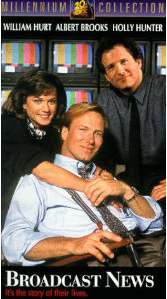 At the center of Brooks’ very intelligent movie is a very intelligent triangle: Holly Hunter (in the role that made her a star) as feisty Georgia-born TV news producer Jane Craig, Albert Brooks as her best friend (who loves her), brilliant but nervous urban-born reporter Aaron Altman, and William Hurt as the man who comes between them (and between us and the news), a somewhat unschooled but fabulously telegenic news anchor named Tom Grunick.
At the center of Brooks’ very intelligent movie is a very intelligent triangle: Holly Hunter (in the role that made her a star) as feisty Georgia-born TV news producer Jane Craig, Albert Brooks as her best friend (who loves her), brilliant but nervous urban-born reporter Aaron Altman, and William Hurt as the man who comes between them (and between us and the news), a somewhat unschooled but fabulously telegenic news anchor named Tom Grunick.
The romantic fireworks are complicated by the fact that Aaron, whom we should be rooting for, is something of a pretentious prick at times and that Tom is a genuinely nice and even sensitive guy (albeit with flaws we will discover), and that workaholic Jane may be married more to her job than, potentially, she could be to either of them.
Broadcast News has one of the finest, smartest endings on any modern romantic comedy, and this Criterion edition has a deleted ending that’s pretty good too, plus a whole deleted subplot and character that‘s better than most of the rom-coms (good name for them) you see now. (The ending they finally used is better; the one they discarded would have made the movie a bigger hit.)
The supporting cast is marvelous: Joan Cusack, Robert Prosky, Lois Chiles, a snippet of John Cusack — and Jack Nicholson (who won an Oscar, with the peerless Shirley MacLaine, in Brooks’ Terms of Endearment”) in a wonderful cameo as a self-infatuated news anchorman who makes the Moore show’s Ted Baxter look like a modest dude.
The saddest thing about Broadcast News, other than the mess that’s been made of network TV news in the intervening decades, is that Brooks just released How Do You Know, a mediocre new picture (with Nicholson in support again), with a similar triangle of Reese Witherspoon, Owen Wilson Paul Rudd, but without the sharp social and cultural commentary, an uninspired, not very funny, not overly smart rom-com full of ideal modern TV anchor material.
It makes you yearn for what Brooks could do on Broadcast News, with the two-scenes and the three-scenes involving his earlier star trio, or with the spot-on recreations of the boadcasts, or with little unexpected bits like that terrific scene where, after a bloody massacre of firings in the newsroom, the full-of-himself network exec asks one older victim if there’s anything he can do for him, and the sacked vet replies, with admirable smiling aplomb, “Well, I certainly hope you die soon.” Wish I’d had that line.
Extras: Commentary by Brooks and editor Richard Marks; Documentary on Brooks; Alternate ending and deleted scenes, with Brooks commentary; Video interview with CBS news producer (and Jane Craig model) Susan Zirinsky; Featurette with on-set footage and interviews with Hunter and the two Brookses. Booklet with Carrie Rickey essay.
PICK OF THE WEEK: BOX SET
Alien Anthology (Blu-Ray) (Four Stars)
U.S.: Various Directors, 1979-97 (Twentieth Century Fox)
 The astronauts aboard the starship Nostromo — including the seemingly indestructible Ripley (Sigourney Weaver) — run into a horrendous and all but unkillable space monster. And since the first movie, directed by Ridley Scott, became a big hit and modern classic, the monsters kept coming back. So did Ripley.
The astronauts aboard the starship Nostromo — including the seemingly indestructible Ripley (Sigourney Weaver) — run into a horrendous and all but unkillable space monster. And since the first movie, directed by Ridley Scott, became a big hit and modern classic, the monsters kept coming back. So did Ripley.
This is one of the most visually spectacular, tense, horrific, and thrilling of all science fiction series, with two of the most visually compelling antagonists (Weaver as Ripley, and the Aliens) and one of the most creative star director rosters: Scott, James Cameron, David Fincher and Jean-Pierre Jeunet. The video and DVD reissues keep coming back too, but this one may be definitive for a while.
Included: Alien (U.S.: Ridley Scott, 1979, 2003) Four Stars. With S.W., Tom Skerritt, Ian Holm, Harry Dean Stanton, Yaphet Kotto, Veronica Cartwright and John Hurt (who lends his torso to one of the scariest moments in movie history). Contains both the original 1979 theatrical version and Ridley Scott’s 2003 Director’s Cut.Aliens (U.S.: James Cameron, 1986, 1991) Three and a Half Stars. With S.W., Michael Biehn, Bill Paxton and Lance Henriksen. Ripley goes looking for aliens again. She finds them. Not as good or dramatic as the first picture, it’s still one of the most continuously exciting, step-on-the-gas and slam-you-to-the-wall movie roller-coaster rides ever. Contains both the original 1986 theatrical version and Cameron’s expanded 1991 “Director’s Cut” Special Edition.
Alien3 (U.S.: David Fincher, 1992, 2003) Three Stars. With S. W., Charles S. Dutton, Charles Dance, Henriksen and Pete Postlethwaite. Ripley on a prison planet. Guess who shows up. Fincher’s first big blast. Contains both the original 1992 theatrical version and the expanded 2003 Special Edition (Restored Workprint Version).
Alien Resurrection (U.S.: Jean-Pierre Jeunet, 1997) Three Stars. With S. W. (or her clone), Winona Ryder, Ron Perlman, Brad Dourif, Dan Hedaya and Dominique Pinon. Ripley clone and young Ryder run into some old friends. God damn, they’re hard to kill. Contains both the original 1997 theatrical version and the 2003 expanded Special Edition.
Extras: Five commentaries, one with Scott alone on the original “Alien.“ Among those participating on the others four: directors Scott, Cameron, and Jeunet, writer Dan O’Bannon, cinematographer Alex Thomson, editor Terry Rawlings, tech artists Stan Winston and Richard Edlund, and actors Weaver, Hurt, Skerritt, Stanton, Cartwright, Biehn, Paxton, Henriksen, Perlman and Pinon. Also: Documentary; Featurettes; Interactive notes; Deleted and extended scenes; TV Specials; Multi-Angle studies; Photo and still galleries; Isolated scores by Jerry Goldsmith (Alien), James Horner (Aliens), Elliot Goldenthal (Alien3), and John Frizzell (Alien Resurrection).
OTHER CURRENT AND RECENT DVD RELEASES
The Princess and the Frog (Three Stars)
U.S.; John Musker & Ron Clements, 2009 (Walt Disney)
Where have John Musker and Ron Clements been all these years?
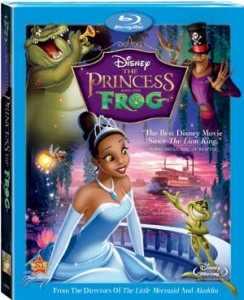 There were very few feature cartoons in the current, resurgent animation era I’ve enjoyed as much as I did Musker and Clements’ The Little Mermaid, (1989), with its buoyant ocean-floor showstopper “Under the Sea,“ — or Aladdin, (1992) with its take-no-prisoners comic genie turn by a blazing Robin Williams. Both those movies also (mostly) had terrific Howard Ashman-Alan Menken song scores. (We may forget how dominant that pair seemed in the Oscars, before Ashman’s premature death from AIDS.)
There were very few feature cartoons in the current, resurgent animation era I’ve enjoyed as much as I did Musker and Clements’ The Little Mermaid, (1989), with its buoyant ocean-floor showstopper “Under the Sea,“ — or Aladdin, (1992) with its take-no-prisoners comic genie turn by a blazing Robin Williams. Both those movies also (mostly) had terrific Howard Ashman-Alan Menken song scores. (We may forget how dominant that pair seemed in the Oscars, before Ashman’s premature death from AIDS.)
Since then, Musker and Clements have done a couple of so-so films, Hercules and Treasure Planet. But they’ve been relatively low-profile, even as the form they revived and mastered in The Little Mermaid has come to seem more and more passed by. The old-fashioned 2D animation style, complete with an original Snow White-style song score, has been increasingly replaced by computer animation specials, with minimal or no songs.
Still, the witty, lively memory of “Mermaid“ and “Aladdin” lingered on.
Now comes The Princess and the Frog, which I really enjoyed. Musker and Clements co-write (with others), as well as co-direct their movies, and the best of them snap, crackle (pop). They have real comic/verbal style. The characters are pungent. The dialogue is fast, funny, crisp. And the old-style flat animation doesn’t jazz you up or wear out your eyes, the way non-Pixar computer stuff often does.
The movie also gets a big plus, because, without condescension or fuss, it puts a black heroine and her family at the center of the story: plucky Tiana (Anika Noni Rose), who wants to run a post-WWI New Orleans restaurant in remembrance of her late gumbo virtuoso dad, and a gal who kisses a frog in order to turn the pesky amphibian into her benefactor, Prince Naveen (Bruno Campos).
Bad move, Tiana. The Catch-22 is that Naveen has been hoodooed by the perfidious Dr. Facilier (Keith David, smoking), and Naveen doesn’t turn back into a prince; instead, she turns into a frog. And that throws her and Naveen into a swampy odyssey where they run across trumpet-blowing alligator Louis (Michael Leon Wooley, who makes up for the absence of either Louis Armstrong or Louis Prima), wise little firefly Ray (Jim Cummings) and witchy Mama Odey (Jennifer Lewis). All these characters have more life and sass than the average live action movie gives you, and better dialogue and songs to boot. Hell, the movie even has better action at times.
This is a good show, alive in all areas, including Randy Newman‘s unjustly carped-at (in some circles) score. One day we won‘t have Newman around anymore to do his great funny, ironic, catchy stuff, and we’ll miss the dude. And his car. (“Santa Monica! We love it! We love it!“) If Ashman and Menken were the Cole Porters of feature cartoon songwriters, Newman is the Johnny Mercer. Hey, if the cat’s name was Dandy Klewman, they might be hailing him now as a bright new discovery, instead of calling him tired. He isn‘t, and neither are Musker and Clements.
Extras: DVD, Blu-ray and digital copies; Commentary by filmmakers; Deleted scenes; Featurettes; Music videos; Games.
Life as We Know It (One and a half Stars)
U.S.; Greg Berlanti, 2010
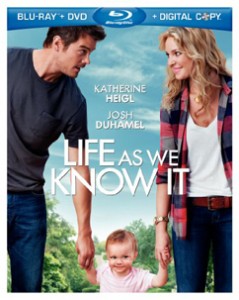 Even as we speak, American film romantic comedies get glossier and glossier, sillier and sillier, more and more awash in clichés and glamour-puss nonsense. Take this movie. (Please!) Its premise is simple and ridiculous: Gorgeous Holly Berenson (Katherine Heigl of “
Even as we speak, American film romantic comedies get glossier and glossier, sillier and sillier, more and more awash in clichés and glamour-puss nonsense. Take this movie. (Please!) Its premise is simple and ridiculous: Gorgeous Holly Berenson (Katherine Heigl of “
Knocked Up, a good romantic comedy) and studly Eric Messer (Josh Duhamel, of Win a Date with Tad Hamilton, a bad one) have a date with each other, thanks to their matchmaking best friends. Holly looks a little like a less saucy Diane Lane. Eric looks like an elongated Rob Lowe.
They don’t like each other, because he’s a sort of a jerk and an ostentatious stud, and she’s got a temper. Nasty surprise: Their friends later die in an accident, and their will stipulates that Holly and Eric must live together in the late friends’ old house and bring up little baby Sophie (played by three Clagett family tots and two Liddells). That‘s one of the stranger damned wills I‘ve ever heard of, but no lawyer in Atlanta is apparently smart enough to crack it, and Sophie is a little sweetie, so Holly and Eric movie in together — even though he’s a TV director for the Atlanta Hawks, and she has some important glamorous desirable well-paying job that slips my mind. Maybe she’s an agent for romantic comedy movie scripts?
Never mind. They’ve been maneuvered into the house together: the hunk and the babe. Complications now arise. Will they bicker? Will they bond? Will they fall in love? Will they do it? Will Josh Lucas, as kindly doctor Sam who dates Holly, mess everything up? (Sam looks like a less sporty Paul Newman.) Will Sophie do cute things and take her first steps? One really wonders.
Part of the problem here is that Eric is such a selfish obnoxious guy, that you keep wanting him to be arrested for reckless egotism. But, since this is a movie, and he’s the top-billed guy, we know he’ll be domesticated, prove to have a kinder, gentler side. When the filmmakers want him to express deep feeling they have him strip to his underpants — an image that so entranced the marketing department they’ve put Josh in boxer shorts on the “Life” poster, with K. H. and one of the baby Sophies.
Josh Duhamel is no Steve Martin and Katherine Heigl is no Goldie Hawn. They’re no Kate and Spence either. Or Carell and Fey. Or Lucy and Ricky. Or Burns and Allen — and frankly what this movie needs is less glamour, and more laughs. But Life as We Know It keeps throwing away comedy as we know it and comic opportunites, such as a possible messed-up double date night where everybody runs into each other at the house and refuses to leave. The writers (Ian Deitchman and Kristin Rusk Robinson) toss away laughs and concentrate instead on glamour, deep feelings and hot underpants.
Extras: Featurettes; Deleted scenes.
You Again (Two Stars)
U.S.; Andy Fickman, 2010
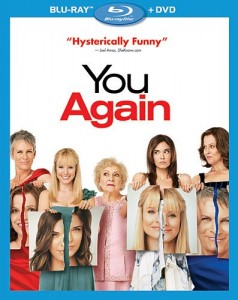 Another terrible movie romantic comedy, which, out of respect for my old screen crush on Jamie Lee Curtis (“I’m very good at saying ‘Yes.’”), I should probably ignore. But duty calls.
Another terrible movie romantic comedy, which, out of respect for my old screen crush on Jamie Lee Curtis (“I’m very good at saying ‘Yes.’”), I should probably ignore. But duty calls.
Consider this truly ludicrous premise. A now successful glamour-yuppie named Marni (Kristen Bell), who was bedeviled all through high school by sadistic schoolmate Joanna (Odette Yustman), discovers that the “ideal” girl marrying her best-pal brother …is Joanna!
Wow! Who knew! But wait, there’s more. Once everybody gets to the wedding, Marni’s mom Gail discovers that the sadistic schoolmate Ramona (Sigourney Weaver) who bedeviled her all through high school….is Joanna’s mother!
Wow! Incredible! Wonders never cease!
But what’s with all these people? Are they suffering from on-again, off-again amnesia? Don’t any of them gossip? Didn’t any of them ever hear of Facebook? More complications: Marni starts to turn into a face-blemished nerd again, just like high school. Gail and Ramona start squabbling again, just like high school. Old flames show up and go psycho, just like high school. The movie and the wedding dissolve into chaos and silliness, just like high school. If all these people would just sign on for a transfer to a remake of “Back to the Future, Part One” all their problems would be solved.
Written without fear by Moe Jelline, and directed without seeming qualms by Andy Fickman, “You Again” is the sort of movie you’d like to be shown at your high school reunion — to all the classmates and teachers who annoyed or bedeviled you. But…Hey! Betty White is also in this, her career resurgent, playing Grandma Bunny, a real card. Right on, Moe and Andy!
Strangely, Grandma Bunny does not seem to have had a sadistic schoolmate who bedeviled her all through high school, not even one called Elmafudda or Daffyducka, who could be worked into a cameo for Mary Tyler Moore or Georgia Engel. But maybe that’s all for the best. How could anyone get away with bedeviling Betty White?
Extras: Featurettes; Deleted scenes.
KNOCK OF THE WEEK
Paranormal Activity 2 (One and a Half Stars)
U. S.: Tod Williams, 2010
There’s an ugly rumor going around that Paranormal Activity 2 is a really scary movie. Well, not the one I saw. That “Paranormal Activity 2” — a sort of sequel, sort of prequel to last year’s ultra-low-budget ultra-smash hit about a squabbling couple and their fight with demonic possession, as recorded on home movies and video surveillance — is about as frightening as gazing from a fixed position into a microwave oven at a slowly cooking bowl of Orville Redenbacher gourmet popcorn.
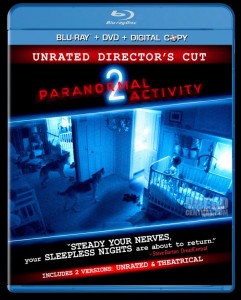 I’m serious. If you think you might jump with fright when that corn actually starts popping (POP!! POP!!!! POP!!!!!!), then you might be similarly terrified at the slamming doors and sudden loud clangs, the invisible spooks and fast-forwards or skips in the tape that are some of this new movie‘s main bag of tricks — not to mention all the mysterious, horrendous stuff going on off screen that the “Paranormal 2’” characters, especially a barking dog and a crying infant in a playpen, are staring at, but that you can’t quite see.
I’m serious. If you think you might jump with fright when that corn actually starts popping (POP!! POP!!!! POP!!!!!!), then you might be similarly terrified at the slamming doors and sudden loud clangs, the invisible spooks and fast-forwards or skips in the tape that are some of this new movie‘s main bag of tricks — not to mention all the mysterious, horrendous stuff going on off screen that the “Paranormal 2’” characters, especially a barking dog and a crying infant in a playpen, are staring at, but that you can’t quite see.
Me, I was mainly rattled by the empty performances, the third-rate script, the pointless yammering pseudo-real dialogue, the low-tech, imitation surveillance tape camerawork, and all the unimaginative grabs and knockoffs from the first movie. And at the fact that I had to pay six dollars for a civilian’s ticket to see the damned thing. Sheeesh! I would have been better off buying the popcorn.
Seriously. Sort of.
I’m not trying to be Mr. Unspookable “You-can’t-scare-me” here. I‘m fully aware that 40 million dollars worth of supposedly terrified moviegoers lined up to climb into the theatre seats and then jump out of them, at innumerable showings of “Paranormal Activity 2” its first week. And that lots of smart critics seem to like it.
It’s hard as hell, though, for me to figure the appeal of something like “Paranormal 2” — another sequel that tries to do everything the first movie did, and somehow justify copying it. I know that teen couples like to scream and grab each other in the dark. And the first “Paranormal” worked. It had a very clever low-budget, low-tech idea, somewhat like the first Blair Witch Project.
In minimal or nervous camerawork trained on mockumentary scenes and verite performances, the original Paranormal showed us troubled Katie and compulsive filmmaker Micah, a combustible couple played by actors Katie Featherston and Micah Float, try to get Katie over her fears of being a poltergeist-target or demon magnet, while using Micah’s home movie camera, and a surveillance camera in their bedroom, to try to spot and catch things going bump in the night. All the movie’s camerawork was amateur hand-held or fixed-position stuff, sometimes with an eerie blinking time code in the frame. And, to nobody‘s surprise the things bumping in the night, caught on candid camera, were something really bad that we couldn’t quite see.
The first Paranormal Activity cost (initially) about $11,000, and made a mint. This one cost 3 million or so — and the law of diminishing returns, and diminishing movies, applies.
“Paranormal 2” is supposedly set two months before the other one. As we watch, supposedly transfixed, Katie‘s spookable sister Kristi Rey, (Sprague Grayden), her phlegmatic husband Daniel (Brian Boland), her venturesome stepdaughter Ali (Molly Ephraim), her inquisitive new infant son Hunter, the family’s ghost-savvy housekeeper and that vigilant, barking dog (the only character in the movie whom I thought had any sense) settle into a new house. And that house is burgled, trashed (but not robbed), causing them to put up six surveillance cameras — over the bedroom, living room, kitchen, foyer, entrance and swimming pool — thereby making sure they and we can get a movie out of this.
Micah appears before-hand, with his camera, and we sometimes get little titles, informing us that it’s six months (maybe) before his death, or so and so many days before his death — which made little sense to me, but may have been there to stop any wise-acres in the theatre from shouting “Hey, wasn‘t that the dude that got offed in Paranormal Activity !?” (“Shhhhh!”) This “Paranormal“ also begins with another title, I think, thanking the police and citizens of Carlsbad, California. So I guess this was supposed to be a documentary assembled from those six surveillance tapes, cut into poor Micah’s peek-a-boo home movie stuff perhaps nixed from the “Deleted scenes” extras section on the “Paranormal I” DVD.
Those six high-angle cameras — fuzzy during the day, greenish during the night — gradually reveal a tale of terror. Something is sneaking around the house. But we can’t quite see it, unlike the more perceptive crying infant and the more prescient barking dog.
SPOILER ALERT, I guess, but who really gives a crap?
Every once in a while, a door slams! Or a spoon falls! Or the wall slams! Or the furniture moves! Or the pool cleaner does some weird thing! Or a door swings shut when Ali goes outside! Or some unseen something or other messes with the dog or infant Hunter! The scares just keep on coming.
Finally something truly terrible happens, but we can’t quite see it. In between, we get dialogue and performances of daytime soap opera quality, with the actors portraying a bunch of characters who don’t seem to have their heads screwed on straight. (Don’t any of them ever watch these tapes?). And, of course, we get another reminder that there are only a few more weeks or days or minutes until Micah gets killed. (“Hey, wasn’t that the dude…?” “SHHHHH!”)
END OF SPOILER
Oren Peli was the writer-director who ingeniously pulled off the first “Paranormal,” but here he’s upgraded himself to producer, no less, engaged by now in Paramount Activity . (Maybe, by the time of the next sequel-prequel, he’ll be a mogul.) The new director is Tod Williams, who, back in 2004, made that pretty good, touching Jeff Bridges–Kim Basinger domestic drama The Door in the Floor (Perhaps someday there will be college courses on “The Significance of ‘The Door’ in the Cinema of Tod Williams.”) I thought the screenwriters here gave all the good lines to the dog, but the dog was a pro. He was totally convincing, always hit his marks, and he never upstaged anybody, not even the ghost-savvy housekeeper. (Good boy. What’s his name anyway?)
As for cinematographer Michael Simmonds, he may have stumbled onto the cushiest camera gig around. Did he just set up the surveillance cameras here, hand a video recorder to Micah (who has only ten more minutes to live) and head out for Santa Monica and the beach? (“Hey dude! Aren’t you the guy from ‘Paranormal Activity?’”) I guarantee you, we probably couldn’t tell the difference if he did.
Why has this nothing of a movie, this unimaginative uninteresting knockoff sequel, attracted such massive (and apparently appreciative) audiences and gotten such widely laudatory reviews and indulgent praise from so many critics? Are audiences lost in fond memories of the first show? Have they really been scared witless? Are the critics good-heartedly applauding the low-gore quotient and the so-called ingenuity with which the filmmakers shoehorned an easy way to repeat stuff and ideas from the first movie into this one?
Are we supposed to be happy that the filmmakers, with admirable restraint, aren’t showing us the things we don’t want to see anyway? Are we critics trying to prove we’re populists, plugged into the crowd? Or have we discovered in the “Paranormal Activity” surveillance camera a rigorous classical minimalism worthy of Romanian cinema? (“Micah has 4 Months, 3 Weeks and 2 Days to Live.”)
Meanwhile, it’s all cool, dude, all cool. Micah (who’s got five seconds to live) and that “Paranormal” camera guy are down at the beach. So is the dog. Surf’s up! (“Hey, aren’t you the dudes…?”)














Amir Bar-Lev covered a lot of ground in only 94 minutes (he cut his film down from his initial 2 1/2 hour cut). At times the film rushes through the material passing over details. Including some of his cut (and new) footage in the DVD extras would have fleshed out the story.
Further, Bar-Lev ended his film with the August 2007 Congressional hearing. I believe his film (or DVD extras) should have also told the “untold story” of how President Obama and the Democratic Congress continued the Bush administration cover-up of Tillman’s friendly-fire death up to protect Gen. Stanley McChrystal through his June 2009 Senate confirmation hearing. Instead, Gen. McChrystal (who supervised the Army’s cover-up and the writing of the fraudulent Silver Star) was barely a footnote in the film.
To fill in the details, I’d suggest starting with Gary Smith’s profile “Remember His Name” (si.com 9-11-06), Mike Fish’s “An Un-American Tragedy” series (2006 espn.com), and the most recent profile by Mick Brown “Betrayal of an All-American Hero” (The Telegraph 10-07-10).
For books, I’d suggest Mary Tillman’s memoir “Boots on the Ground by Dusk” (at http://www.blurb.com/ with a preview) which the film was largely based upon, or Jon Krakauer’s “Where Men Win Glory” (although Krakuaer has the most detailed account of the actual friendly-fire incident, his biographical material is flawed since Krakauer lost the cooperation of most of the Tillman family and ignored the Democratic role in the bipartisan cover-up.
For blogs, try John T. Reed’s Tillman posts (see his “military articles” at johntreed.com) and “The [Untold] Tillman Story” at the http://www.feralfirefighter.blogspot.com (updated soon).
I had trouble finding work for over a year figured out how to start makeing money online at This work from home site. I was suprised how quickly I got my first check. I really hope other people are able to earn money online like me.